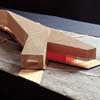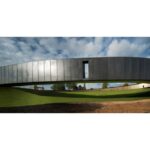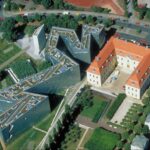Paladru Archaeology Museum, Park, France, Architect, Photo, Building, Image
Paladru Archaeology Museum and Park : French Building
French Archaeology Museum Architecture by Hérault Arnod Architectes
9 Dec 2008
Lake Paladru Archaeology Museum and Park
Date built: 1996
Design: Hérault Arnod Architectes
LAKE PALADRU ARCHAEOLOGICAL MUSEUM AND PARK
At the heart of the Terres Froides (Cold Lands), Lake Paladru has created a remarkable landscape, a territory made up of hills and unified by the standing water of the lake. The museum site is an extensive protected wetland, at the western end of Lake Paladru. The museum will house objects found in the remains of Neolithic and mediaeval villages submerged under the waters of the lake that are subject to yearly aquatic excavating. The wetland where the museum-park will stand offers a particularly rich ecological environment, because of its position at the interface between water, earth and air. The museum’s architecture, poetic and mysterious, emerges from the landscape, in a quest for fusion with nature.
The building extends along a 160 metres long axis, perpendicular to the contour lines: it is situated “with the grain of the water”. It is elevated so as not to create a break in the landscape. The extension to the reed bed around the building will emphasise this effect of a thing that has sprung from nature. The wetland is not interrupted and seems to run under the building, which is above, at the level of the canopy. The “underside” is a wide, roofed pontoon, which extends far out into the lake and contains all the accesses: public, staff, boat moorings, starting point for walks in the park and to reconstructions of Neolithic and mediaeval villages. The museum will be a landmark in the landscape. It resembles a branch, whose main stem and twigs bend to meet the axis of the lake. This reference to plant morphology gives the structure a certain freedom, despite the fact that it is built to a strict controlling plan. Its identity comes from a paradoxical mix between mimetism with nature and belonging to the technological world, between archaism and futurism. An “attractive strangeness” reveals itself from this fusion.
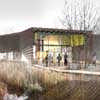
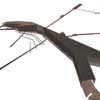
Images : Kilinc – Wallon, Hérault Arnod
The variations in the design are induced by the content, by the succession of themed spaces that form the itinerary. The structure is composed of facets which intersect to create ribs, generating shifting and dynamic spaces inside, which vary along the route. There is no separation between container and content. The architecture is perceived as the first element in the museum’s exhibition space. It is a casket-museum: for visitors to become immersed in each historical era, they must be encouraged to break free of the present. The tour of the museum is linear and chronological, a sequence of all the itineraries available in the park. From the entrance hall, the stair is an airlock between today and the past in which one is going to dive into. The visit starts with the Neolithic room, a continuous blue volume; one then crosses the “accelerated time” room, an entirely glass space inside the wooden lattice; then one enters the Year 1000 room all painted in red. At the end of the museum, a large automatic door opens onto the landscape. The route ends with a ramp above the water, which descends to the axis of the lake.
The museum design creates an alternation between opaque and transparent spaces. To generate a unified whole and avoid breaking up the lines, all sides of the structure are enveloped in a wooden lattice which suggests an airy web in its construction. By contrast, the background materials of the facades, behind the lattice, will be bright, as if precious: glass, metal, coloured lacquerwork, etc. By erasing the traditional attributes of a building (doors, windows, roofs, etc.), the project conveys an abstract impression. By allowing a glimpse of the structures contained within, like objects in a basket, the filter contributes to the mystery.
The very light construction principle aims at minimizing the impact on the site and to reduce the number of foundation points to avoid disrupting the ground. The museum’s structure is made up of successive wooden frames, each different from one another to create the form and set 1.25m from each other. These frames rest upon two longitudinal steel beams supported by a series of columns set 12 to 15 meters from each other and based upon 25 meter deep piles.
“The lake made the garden. Everything is composed around this thinking water. The lake is a great tranquil eye. It receives all the light and with this light it makes a world. The world is contemplated, the world is represented by the lake. “
Gaston Bachelard
Paladru Archaeology Museum and Park – Building Information
Location
· Montferrat, Paladru Lake
Client:
· Isère Regional Council
Project management
· Hérault Arnod Architectes – architecture and scenography design
Project team : Eric Alfiéri (project manager), Patrick Arrighetti, Camille Bérar, Matthias Jäger, William Tenet
· Cap Paysage, landscape, joint representative
· Biotech, ecology
· Batiserf, structure
· Nicolas, fluids
· Michel Forgue, economics
· Eric Leprince, graphic design
· Nadine Salabert, museum design
· Hervé Audibert, lighting
Area
· 2,600 m2 total floor area
Cost budget
· Building + stage design: €4.73 million excluding VAT
· Exteriors: €1.52 million excluding VAT
Timetable
· Definition plan 2000
· Signature of project management contract April 2001
· Tender 2004
· Delivery? The project is currently frozen because of administrative problems linked to the planned operation on the wetland.
Programme
· Permanent exhibition rooms, one focusing on the Neolithic village, the other on the year 1000
· Temporary exhibition room
· Workshops for school parties
· Lecture room
· Café
· Administration
Models Michel Dioudonnat, Hérault Arnod
Photos © André Morin
Images Kilinc – Wallon, Hérault Arnod
Paladru Archaeology Museum and Park, France photos / information from Hérault Arnod Architectes Dec 2008
Location:Lake Paladru, France
New Buildings in France
French Architectural Projects
French Architect Offices – design firm listings
Paris Architecture Tours by e-architect
Zenith Music Hall Strasbourg
Massimiliano Fuksas Architecture
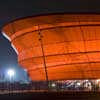
photo : Moreno Maggi
Biscuit House, nr Lyon
Pierre Minassian architect

picture from architects
Comments / photos for the Paladru Archaeology Museum and Park page welcome
Paladru Archaeology Museum France

